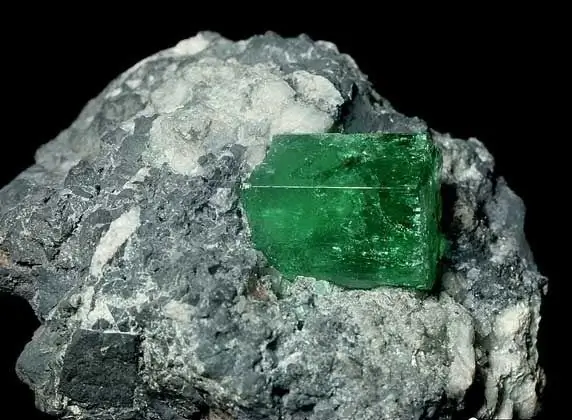- Author Nora Macey [email protected].
- Public 2023-12-16 10:17.
- Last modified 2025-01-23 08:48.
Emerald, along with alexandrite, diamond, pearls, amber, ruby and sapphire, according to the officially accepted international classification, is considered a gem. This means that its cost is initially high. However, it also depends on indicators such as color and purity.

General information about the emerald
Emerald belongs to a variety of beryl mineral, which is colorless in its pure form. The color of beryl is due to the presence of chromium, iron and vanadium impurities. Beryls with a color above a certain value are called emeralds. They must contain at least 0, 14% chromium, and at least 0, 12 and 0, 05% iron and vanadium. The main deposits of this gem are located in Colombia, East Africa, India, Pakistan and Russia, in the Urals, near Yekaterinburg.
This is a stone, which is transparent and translucent crystals of an elongated prismatic shape with a green color of varying degrees of intensity. Colombian emeralds, which have an intense grassy green color, are especially prized. It is the bright glow of the most diverse shades of green that makes the emerald a unique and one-of-a-kind mineral so highly prized.
The purity of the emerald
Unlike a diamond, small inclusions and cracks are not a particular drawback and do not in any way reduce the value of an emerald, serving as proof that the stone is of natural origin. A stone with a rich color with such small defects will cost much more than a clear and transparent, but having a pale green color.
The purity of emeralds in the West is assessed on a special seven-point scale from VVS to I3. At the same time, stones with a VVS purity are characterized by minor inclusions, which become noticeable only at 10x magnification and are almost invisible to the naked eye. These are top quality stones. Emeralds with a clarity of I3 are characterized by the presence of inclusions visible to the naked eye and affecting the appearance of the stone. Such specimens are fragile and short-lived.
In Russia, the purity of emeralds is rated on a 5-point scale. The first group includes transparent stones with inclusions that are not visible without a magnifying glass, the second - transparent with visible inclusions, the third - with a partial loss of transparency and numerous inclusions. The fourth and fifth groups include stones with partial or complete loss of transparency and a large number of natural defects.
Natural cracks and splits, which are often found on the surface of emeralds, are treated with cedar oil, which has the same refractive index as this noble stone. This makes many of these defects invisible. For this purpose, Brazilian and Colombian emeralds are processed in thermal and vacuum installations, where cracks in the stones are filled with epoxy resins.






